There’s Life in These Streams!
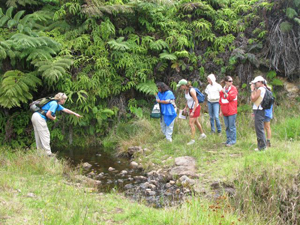 Photo: Melora Purell describes life in the stream to participating teachers on their field trip.
Photo: Melora Purell describes life in the stream to participating teachers on their field trip.
Participating with the HI-MOES Program allows our school to take advantage of a wonderful outdoor classroom experience. After just one trip my students have begun asking questions such as: ‘Is there life in these streams?’; ‘Should the waters of Pelekane be clearer?’; ‘How long did it take for the watershed to get this way?’; and ‘How do we get the water to be clearer?’ They are excited to know they will be returning to study the forest and are looking forward to school next semester!”
–Sylvia Texeira, Middle School Teacher, West Hawai‘i Explorations Academy
The Kohala Center (TKC), in partnership with the Kohala Watershed Partnership (KWP), received a grant from NOAA’s B-WET Program for HI-MOES (Hawai‘i Island Meaningful Outdoor Experience for Students). This one-year program aims to build on the previously funded HI-MEET program (Hawai‘i Island - Marine Environmental Education for Teachers).

Photo: Participating teachers spent the day together meeting with TKC and KWP staff and exploring the dry and wet forest of Kohala Mountain.
In September 2009, 14 teachers and their 500 students were recruited into the HI-MOES program. The program kicked off with a teacher meeting and field trip in Kohala. Since September, TKC and KWP educators have been meeting with teachers and students to conduct classroom presentations or field trips focusing on watersheds, bays, coral reefs, and human impacts on these ecosystems.
HI-MOES teachers will be supported throughout the year by subject matter and outdoor education experts: Samantha Birch, The Kohala Center’s field educator, and Melora Purell, coordinator of The Kohala Watershed Partnership. These educators provide scientific oversight of the field projects and personalized advice on how to integrate field learning with classroom science lessons.  Science specialists and cultural practitioners are also participating in the classroom presentations and field trips, including professional scientists from Cornell University, such as Courtney Couch and rangers from Pu‘ukoholā Heiau National Park.
Science specialists and cultural practitioners are also participating in the classroom presentations and field trips, including professional scientists from Cornell University, such as Courtney Couch and rangers from Pu‘ukoholā Heiau National Park.
To date, students have discussed their ideas for field-based science projects and most teachers have selected specific projects for their students to focus on for the remainder of the school year. TKC and KWP are assisting with background information for research projects (including classroom presentations and Web resources), site selection for field trips and research projects, and suggesting equipment and supplies needed for research/data collection.
The Kohala Center is also providing funding for transportation and mini-grants to purchase supplies for field-based science projects and to hire substitute teachers while HI-MOES teachers accompany their students into the field. These mini-grants allow teachers to purchase resource books, water testing supplies, tape measures, quadrats, and even mini field computers. “Teachers have so far been very appreciative of our help in overcoming their main challenges to doing science-based field work and have enjoyed the classroom presentations,” reports TKC’s Samantha Birch.
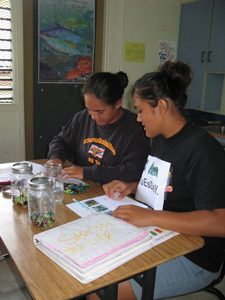 Photo: Students at Ke Kula ‘o ‘Ehunuikaimalino practice the scientific method by counting corals (marbles) in different wave environments (jars).
Photo: Students at Ke Kula ‘o ‘Ehunuikaimalino practice the scientific method by counting corals (marbles) in different wave environments (jars).
The HI-MOES Program will culminate in a scientific conference in May 2010, where students and teachers will share some of their research findings, and guest speakers will be invited to address participating students and teachers.
Visit http://www.kohalacenter.org/himoes/schools.html to learn more about each school’s research project.
Here are some comments from participating teachers and KWP staff:
Photo: HPA 7th grade students on a field trip to introduce them to the wonders of Pu‘u o Umi and expose them to field research. From back left to right: Instructor Melora Purell, Kaliko Smith, Jake Schulman, Eiji Tomita, Makana Arce, Tucker Higgins, Daniel Matsuda, Tori Greco Hiranaka, Kenzie Langmade, Noor Sarwar, Sofia Boucher, Yoo Jung Choi, and Joli Welch.I really feel that science needs to be hands-on and it needs to be student driven. Movement and the use of all our senses are also keys in the art of learning. Field research is the perfect way to meet these needs! Also, students gain knowledge and appreciation for the unique ecosystem present in their own backyards. It is when students learn the value of this ecosystem that they will begin working to preserve it. By being a part of a collective whole with a similar purpose, we are reaching farther than we would as individual teachers. The knowledge that we will be sharing our experiences with other teachers and students from other schools is SO exciting!
–Laura Jim, Middle School Teacher, HPA
Photo: Students at Parker School conducting a marble/jar experiment to study species of bird abundance at different altitudes.The HI-MOES Program is a wonderful opportunity for my middle school science students to be able to design a marine ecology project and get out in the field to collect data and experience hands-on science. My students have chosen Kahalu‘u as their study site to survey keystone sea urchin populations and monitor marine water quality. The HI-MOES staff from The Kohala Center has been fantastic in implementing and
funding our project, making it possible for local students and teachers to participate. –Lisa Diaz, Teacher, Kealakehe Intermediate School
Photo: Melora Purell gives a classroom presentation to Mindy Higgin’s class at Parker School.The HI-MOES Program is a unique partnership that allows students to study and experience Hawaiian ecosystems from a scientific perspective. Without this partnership I feel that many of the students would never see the amazing flora and fauna that once existed on their island. I hope that by providing this experience, students use their new knowledge to respect and protect the living things that surround them and share their experiences with others.
–Mari Taira, Teacher, Waikoloa Middle School
I am so honored to be working with these HI-MOES teachers! They are stretching themselves and their students into realms of field science that are rarely seen in pre-college studies. They want their students to ask authentic questions based on their own observations and experiences in the natural world. It is exciting to introduce these students and teachers to the unique ecosystems on Kohala Mountain, and to see them coming to understand the complexity of the watershed and its native species. –Melora Purell, Coordinator of Kohala Watershed Partnership

 Photo: Jerry Brunetti’s garden in Martins Creek, Pennsylvania.
Photo: Jerry Brunetti’s garden in Martins Creek, Pennsylvania.
The Hawai‘i Island conference is presented by Maui Aloha Aina, which has organized the Body and Soil Farm Health conference on Maui for the past eight years. This year the Maui event will be January 16 and 17 at Kumulani Organic Vegetable Farm.
Last year’s conference on Maui drew about 300 people and really invigorated the Maui community. It is our desire to make this kind of knowledge and expertise available throughout the state by building collaborations with other organizations such as Wai‘aha Farm and The Kohala Center. We envision each island serving its community through educational outreach in restorative and sustainable practices. –Vincent Mina, founder of the Aloha Aina Conferences

Hawai‘i Island conference presenters include:
Photo: Jerry Brunetti.- Jerry Brunetti, 2008 ACRES USA Lifetime Achievement Award Recipient and a consummate communicator of the connection to food as medicine and farm as “farmacy.” Brunetti will speak to the collaborations of the various inhabitants in the human gut.
- Theresa Vernon, mineral tissue hair analysis expert and licensed acupuncturist. She is an expert on treating chronic fatigue syndrome along with metal toxicity to free up the body's ability to uptake nutrients properly.
- Dr. Paul Hepperly, Fulbright Scholar, compost and cover crop specialist, a Rachel Carson Scientist, former director of Rodale Research and senior scientist, and a recognized expert in greenhouse gases and our food system. He worked from 1999 to 2002 with organic ginger farmers on Hawai‘i Island, helping to manage ginger bacterial wilt. He has more than 35 years in agricultural research, management, education and information outreach. His conference presentation ranges from biochar, innovative compost methods, cover cropping, and tillage reduction, to the energy requirements of our food system.
- Michael Martin Melendrez, humus and Micorrhizal Fungi specialist. Owner of Soil Secrets, he coined the term “soil food web” in the seventies and is an expert on humus building and microbial inoculation. He will explain what we can do to grow our soils to prepare for growing plants.
Attendees will come to understand the big picture of what makes up a healthy body and a vital soil. Having this awareness will inspire folks to grow nutrient dense food and to care for the health and well being of their bodies. –Jerry Brunetti
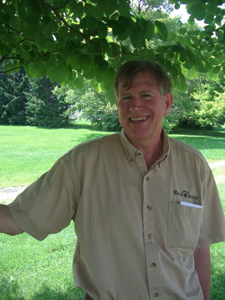
Photo: Dr. Paul Hepperly.
The conference includes a trade show with local holistic and ecological vendors and on-farm demonstrations of whole systems integration with animals, cover crops, and composting. Registration includes locally sourced, nutrient-rich meals. Campers are welcome. The public is invited to meet and greet the speakers at 6 p.m. Thursday, January 21, at the Wai‘aha Farm Community Hall. Call 808-756-7945 for directions.
Wai‘aha Farm consists of 100 acres located on the slopes of Hualalai Volcano, overlooking Kailua-Kona on Hawai‘i Island. It is bordered on the north by Wai‘aha Stream, which in ancient times was the only year-round river on the west side of the island. Queen Emma’s summer palace was located on this site, and King Kamehameha IV had a private farm here, where he grew native crops and experimented with new crops brought by westerners. Over the last 150 years the farm has commercially produced, taro, coffee, macadamia nuts, cotton, and cattle. Today Wai‘aha Farm is transitioning to be a commercially viable, income producing business that serves as a model for 21st century agricultural practices. These practices include soil building, agro forestry, animal husbandry, pasture and farmland reclamation, and integrated vegetable and fruit production.
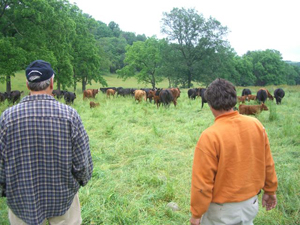 Photo: An example of mob grazing in Pennsylvania. Note the height the pasture is allowed to grow to for mob grazing, in which up to 285,000 pounds of cattle graze per quarter acre. The cattle eat the seed tops off of the grass and then are moved into the next pasture.
Photo: An example of mob grazing in Pennsylvania. Note the height the pasture is allowed to grow to for mob grazing, in which up to 285,000 pounds of cattle graze per quarter acre. The cattle eat the seed tops off of the grass and then are moved into the next pasture.
Registration fees are as follows:
- Two-day registration fee is $150;
- One-day registration (Saturday or Sunday only) fee is $80;
- Camping fee is $15 per day (Friday or Saturday) or $25 for both days;
- Trade show booth fee (includes full conference registration) for two days is $450.
The Hawai‘i Island conference is sponsored by Hawai‘i Farmers Union, ACRES USA, Sam Vessel, NRCS Maui, The Kohala Center, and Volcano Art Center.

Living Traditional Culture
By Kauanoe Kamanā

Photo: Kauanoe and her parents Paul and Ella Kamanā.
I attended Kamehameha Schools from kindergarten, which I entered in 1956, through to my high school graduation in 1969. I remember that there were children there who had families just like mine. My favorite teachers were those who had expectations and aloha and who inspired me to do my best. The great majority of my teachers were not Hawaiian, but those few who were had a distinct knowledge base and behaviors that I could relate to. This held true throughout my schooling at Kamehameha. I had a special respect for these Hawaiian kūpuna (elders) well into my adult years.
I first learned Hawaiian phrases and songs as a child through music at home, at church, and at school. Mrs. Rosehill was our music teacher in elementary school and she taught us the fundamentals of Hawaiian music by singing, not by talking about it. My father taught me to play ‘ukulele and, as students, we sang and played ‘ukulele following lunch every day. Family gatherings and camping trips were always filled with singing Hawaiian songs and playing Hawaiian music, and we also enjoyed singing at Kawaiaha‘o Church.

Photo: Kauanoe at her aunty’s home on Kahakai Drive in Honolulu.
We attended formal Hawaiian class in the 7th grade, and there were Hawaiian language electives in high school and Hawaiian club as an option too. I took French and not Hawaiian at Kamehameha School. However, after seeing how happy my father was when he listened to people speaking Hawaiian on Ka Leo Hawai‘i on the radio on Sunday evenings, I enrolled in Hawaiian language classes at the University of Hawai‘i at Mānoa. My father was pure Hawaiian and it wasn’t until college that I realized how much he enjoyed the spoken language.
My father’s interest, my upbringing as a Hawaiian, my friends’ interest in getting involved in Hawaiian language, and emerging Hawaiian issues all helped to spark my interest in learning the Hawaiian language. My work in Hawaiian language caught the attention of Derek Bickerton, who was part of the linguistics faculty at UH Mānoa, and he encouraged me to enter the M.A. program in linguistics. He later hired me as a graduate assistant to work as an informant on a Pidgin and Creole research project. I continue to be inspired by individuals like Derek, who are knowledgeable and passionate practitioners in their field.
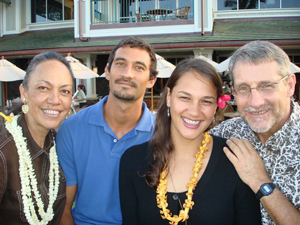
Photo: A recent photo of Kauanoe Kamanā and her family. Kauanoe’s family was one of the first in the Hawaiian language revitalization movement to use Hawaiian exclusively at home. From left to right: Kauanoe, Hulilauākea, Keli‘ihoalani, Pila.
I anticipate finishing my Ph.D. this academic year. For me, writing my dissertation is an opportunity to contribute to the field of Hawaiian education by documenting the outcomes I have observed as an active participant in the field over the past 30 years. I always think of myself as a student, so doing this kind of intellectual work is very fulfilling.
I think managing my various high-priority kuleana (responsibilities) will be a challenge for me this year. As the director of Ke Kula ‘O Nāwahīokalani‘ōpu‘u School, I work with colleagues who are knowledgeable and prepared to ensure that the standards of the school are met while I finish my dissertation. Our school was established in 1994, and our entire school culture is built on these kinds of understandings.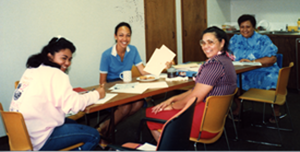
My dissertation explores the mo‘oki‘ina ho‘oponopono, or “Hawaiian cultural system of conflict resolution.” This is a Hawaiian system that is in place at Nāwahī and that can be relevant in other places as well. The context that enables it to be successful is the overall culture of our school or of any organization. The mo‘oki‘ina ho‘oponopono functions as part of that culture and facilitates the improved interpersonal productivity of its participants. As a Hawaiian process, it is part of a network of systems that reflect a Hawaiian worldview. It cannot function alone. I believe this Hawaiian worldview is especially relevant to life in Hawai‘i today.
For the mo‘oki‘ina ho‘oponopono to function at Nāwahī, teachers, staff, and families take on responsibilities in ways that reflect a Hawaiian worldview. Some examples of this are attaining a level of quality in terms of leadership and trusting a leader, giving one’s best effort in beginning and completing an activity, and respecting genealogical order and responsibility. Students who are surrounded with adults who behave and respond in these ways will grow up and emulate these understandings.
This system is an additional strategy for conflict resolution in the schools. It is useful as an immediate way to work within the school community before implementing the Chapter 19 DOE Administrative Rules on Student Misconduct and Discipline. This holds participants accountable and requires patience and discipline on everyone’s part in order to assure an overall successful outcome.

Photo: Kauanoe Kamanā (far right) played an important role in the development of the first Hawaiian language T.V. news program ‘Āha‘i ‘Ōlelo Ola on Sunrise on KGMB9.
The mo‘oki‘ina ho‘oponopono is just one aspect of the Hawaiian medium education system. My research involves observing, collecting data, documenting, and analyzing the mo‘oki‘ina ho‘oponopono, and my work will subsequently generate fundamental principles of the mo‘oki‘ina ho‘oponopono. This will enable me to help students, families, and teachers to participate and, ultimately, recreate the system in other settings. My research will also provide a means to assist with other indigenous language efforts outside Hawai‘i as well. Taking the mo‘oki‘ina ho‘oponopono to diverse contexts and testing its applicability as a Hawaiian process will have a positive impact on how Hawaiian education and the overall Hawaiian worldview is perceived both within academia and in a broader societal context.
My dissertation focuses on data collected at Ke Kula ‘O Nāwahīokalani‘ōpu‘u and investigates how that data reflects the Hawaiian worldview. As a Hawaiian system, the mo‘oki‘ina ho‘oponopono may be replicable in other settings, including other schools. I look forward to working with other laboratory schools of the Hawaiian College at UH and with interested local businesses that may find this system valuable in their settings.
 Photo: In celebration of the 20th anniversary of the establishment of the Kula Kaiapuni Hawai‘i Hawaiian Immersion Program in the Department of Education. From left to right: Hiapo Perreira, Kaleihōkū Kala‘i, Kauanoe Kamanā, and Nāmaka Rawlins.
Photo: In celebration of the 20th anniversary of the establishment of the Kula Kaiapuni Hawai‘i Hawaiian Immersion Program in the Department of Education. From left to right: Hiapo Perreira, Kaleihōkū Kala‘i, Kauanoe Kamanā, and Nāmaka Rawlins.
I am also president of the board and one of the founding members of the ‘Aha Pūnana Leo, which is a grassroots community effort that continues to contribute to the life and welfare of the Hawaiian language and culture. First, as a parent, and then, as a teacher, the ‘Aha Pūnana Leo’s efforts are essential in establishing Hawaiian language as the language of the home. Using the Hawaiian language at the infant/toddler and preschool levels gives parents an awareness of the importance of language and cultural identity as indications of a thriving community. As a result, young parents are now raising their children as first language speakers of Hawaiian in the home. I participate in this effort because it creates the foundation upon which all other Hawaiian language and cultural efforts are based. When Hawaiian medium education is successful, the Hawaiian worldview will ultimately strengthen the unique cultural fabric of Hawai‘i.
The increased number of Pūnana Leo school graduates raising their children as Hawaiian speakers has impacted the number of students who enter Nāwahī as first language speakers. The Pūnana Leo schools have, since 1985, graduated Hawaiian-speaking children who subsequently entered kindergarten classes across the state. The majority of these children were learning English or Hawai‘i Creole English at home. Today, more of those who graduate from the Pūnana Leo use Hawaiian with their parents at home.

Photo: Kauanoe Kamanā (seated left) presents on Self-Determination and Native Education at the All Ivy Conference at Yale University in April 2009.
I recently presented my work at the American Anthropological Association’s annual conference in December in Philadelphia. I spoke about Ke Kula ‘O Nāwahīokalani‘ōpu‘u: Building from the Strength of Native Hawaiian Identity. I provided an overall description of Hawaiian medium education, its philosophy, mission, and program design. I also pointed out relevant aspects of the school experience that relate to Hawaiian identity and to the Hawaiian worldview.
It is an honor to be a part of a national effort to significantly impact groups of indigenous people who would not otherwise have such an opportunity. This is especially significant in Hawaiian communities like ours, where practical applications and the advancement of scholarship should naturally work hand in hand. I am grateful to see that the Mellon-Hawai‘i Fellowship has reached out to those involved in revitalizing Hawaiian language and culture. I am also impressed that The Andrew W. Mellon Foundation supports efforts like mine that range in scope from preschool education through the university level. The Mellon-Hawai‘i Fellowship is helping to sustain the recent promising endeavors to build and strengthen the language and culture of Hawai‘i for all of Hawai‘i’s people.

Photo: Aboriginal students from Taiwan are among many indigenous visitors to Nāwahīokalani‘ōpu‘u School where Kauanoe Kamanā serves as director of laboratory school programs for UHH’s Hawaiian Language College.
My work allows me to continue to build connections with native people and to network with other Hawaiian scholars in the field, including with my mentor Kalena Silva. After I finish the Mellon-Hawai‘i Fellowship, I will return to Nāwahīokalani‘ōpu‘u and to the university. As a college, Ka Haka ‘Ula O Ke‘elikōlani at UH Hilo has as its mission the revitalization of Hawaiian language and culture. My work there will focus on training leaders and administrators, and on expanding the moֹ‘oki‘ina ho‘oponopono based on the model developed thus far.
I believe the mo‘oki‘ina ho‘oponopono can function successfully in coordination with other systems in a variety of contexts. It can serve its purpose within a family, a school, or a business. The implications for applicability of the mo‘oki‘ina ho‘oponopono are far reaching. Wherever Hawaiian language is used, the mo‘oki‘ina ho‘oponopono could also be used. Its utilization in the school context today is an attempt to return this system to its natural context in times past.

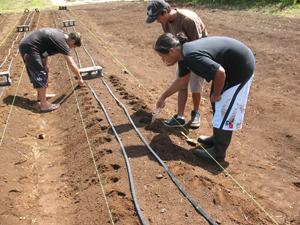 Photo: Students planting bean seedlings in the field system.
Photo: Students planting bean seedlings in the field system.
I think the Agriculture Program is great because this is the only class that I know that lets me go outside. I love to work with my hands and get dirty. –James Maikui, junior at Honoka‘a High School in his first year in the Agriculture Program
Honoka‘a High School Agriculture Teacher Manuel Jadulang graduated from Kohala High School, where he recalls taking agriculture classes and being a member of the Future Farmers of America. Jadulang earned a degree in Agriculture from UH Hilo and a degree in education from the University of Phoenix. This is Jadulang’s third year teaching at Honoka‘a High School. Previously, Jadulang taught at Kohala High School from 2000–2001, then at Kealakehe High School from 2002–2007, where he created an agriculture program “from scratch.”
At Honoka‘a, Jadulang teaches four Agriculture/Natural Resources classes to a total of 130 students. “Some students take my classes because they can relate to working outdoors, and maybe their hobbies include fishing or hunting. Some take them because they sound like a fun elective,” reports Jadulang.
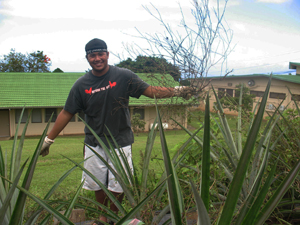 Photo: Clearing weeds from the pineapple patch.
Photo: Clearing weeds from the pineapple patch.
Students in the Honoka‘a Agriculture Program cultivate 11,520 square feet of land and have grown and harvested 225 pounds of food so far this year. All of this food was distributed to staff or students on campus. Food production has increased by 217 pounds since 2008 and, with the assistance of HISGN mentors, Jadulang hopes to increase production even further to support a student farmers’ market on campus once a month and/or a community supported agriculture subscription program for faculty members.
Jadulang enjoys sharing his own knowledge and experiences with students, as well as new trends and techniques, such as aquaponics. “After teaching for several years, it is rewarding to see how students mature over time, especially the students who take my classes for more than one year. I like seeing my former students doing OK in their lives when I see them in the community,” remarks Jadulang. “I stress to my students that they need to establish good work ethics and respect. Many students today lack these skills,” he says.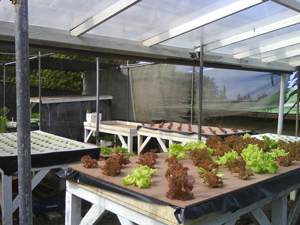
Photo: Hydroponic lettuce grows in this shadehouse system.
Jadulang reports that many of his students do not think of agriculture as a career path because they see agriculture as hard work with low compensation. “Many of them don’t know that agriculture is no longer just farming. There are a wide array of agricultural fields, from forestry to aquaculture, to marketing, to education, to agricultural inspection at airports, to conservation, to biotechnology, and more. I try my best to provide opportunities for students to see all of the aspects of the agriculture/natural resources spectrum,” explains Jadulang.

Photo: Using a template in preparation for drilling holes for green onions in an aquaponic raft.
In 2008, the Honoka‘a Agriculture Program received funds from The Kohala Center’s Hawai‘i Island School Garden Matching Grant program to purchase lumber, irrigation materials, seeds, fertilizer, netting, weedmat, and fuel for its tractor and tiller. “The Kohala Center has also provided moral support for me and for the program. Because of the workshops and networking provided by The Kohala Center, the students and I know that we are not the only ones doing agriculture on the island.
The Kohala Center recently helped to connect Jadulang to Dash Kuhr of the Hawai‘i Youth Agriculture Project in North Kohala, who is mentoring Jadulang on sustainable agricultural techniques during the 2009–2010 school year. “Dash has been giving me ideas to transition our program from traditional agriculture (using chemical fertilizers) to one that is more sustainable,” says Jadulang. “We have been planting our field crops according to the system Dash uses at his farm in Kohala. His system utilizes raised beds, manure (chicken or cow), and cover cropping. Our partnership is going well,” Jadulang concludes.
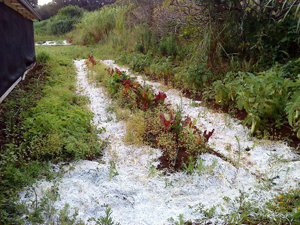
Photo: Mulching paths with recycled paper from the school.
Jadulang invites anyone in the community who would like to volunteer in assisting the Honoka‘a High School Agriculture Program with a range of projects, including:
- coordination;
- helping students with their gardening projects;
- working in the agriculture shop on construction;
- small engine repair; or
- installing additional electrical outlets in the farm areas, etc.,


